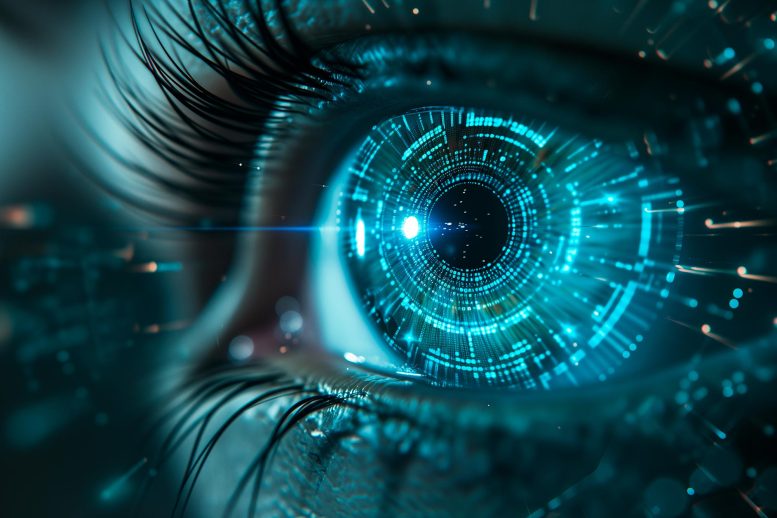
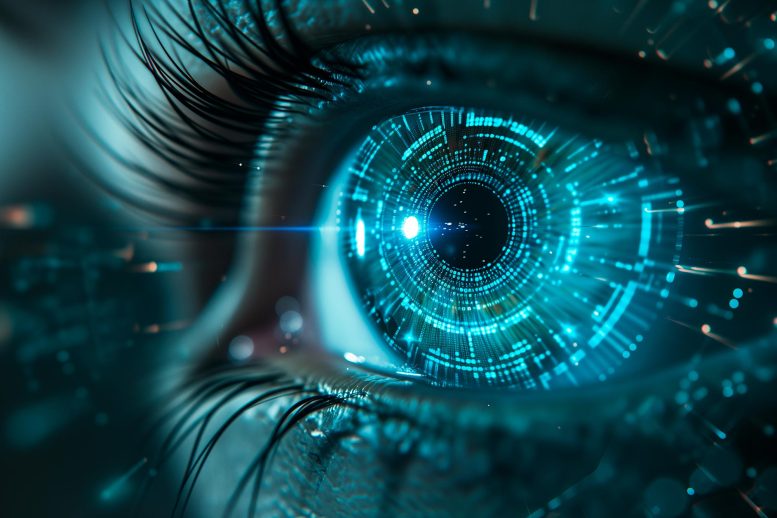
A breakthrough study by Tokyo Medical and Dental University has introduced a machine-learning model capable of predicting long-term visual impairment in patients with high myopia. Using a dataset of 34 variables from eye exams and a patient-friendly nomogram for easy interpretation, this model represents a significant step in combating the global challenge of vision loss. Credit: SciTechDaily.com
Researchers from Tokyo Medical and Dental University (TMDU) develop models based on machine learning that predict long-term visual acuity in patients with high myopia, one of the top three causes of irreversible blindness in many regions of the world.
Researchers from the Tokyo Medical and Dental University (TMDU) developed machine-learning models to predict visual acuity in patients with high myopia. A cohort study of 967 patients was used to evaluate the models. The results show that a regression model accurately predicts visual acuity at 3 and 5 years, and a binary classification model can predict and visualize the risk at 5 years for individual patients, demonstrating potential in clinical assessment and monitoring.
Machine learning has been found to predict well the outcomes of many health conditions. Now, researchers from Japan have found a way to predict whether people with severe shortsightedness will have good or bad vision in the future.
In a study recently published in JAMA Ophthalmology, researchers from the Tokyo Medical and Dental University (TMDU) developed a machine-learning model that works well for predicting—and visualizing—the risk of visual impairment over the long term.
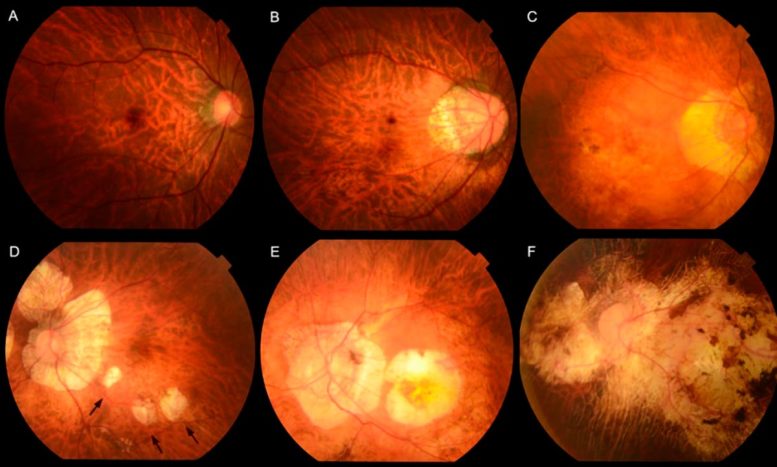
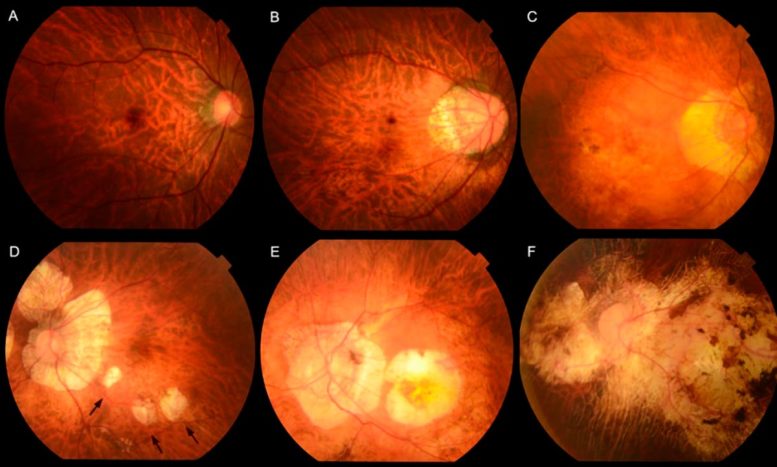
Myopic maculopathy, also known as myopic macular degeneration, is a key feature of pathologic myopia. In the META-PM classification system, myopic maculopathy lesions are categorized into five categories from no myopic retinal lesions (category 0), tessellated fundus only (category 1, Figure 1A), diffuse chorioretinal atrophy (category 2, Figure 1B&C), patchy chorioretinal atrophy (category 3, Figure 1D arrows), to macular atrophy (category 4, Figure 1E&F). Credit: Department of Ophthalmology and Visual Science, TMDU
High Myopia and Its Risks
People with extreme shortsightedness (called high myopia) can clearly see objects that are near to them but cannot focus on objects at a distance. Contacts, glasses, or surgery can be used to correct their vision, but having high myopia is not just inconvenient; half of the time it leads to a condition called pathologic myopia, and complications from pathologic myopia are the leading causes of blindness.
Research Approach and Findings
“We know that machine-learning algorithms work well on tasks such as identifying changes and complications in myopia,” says Yining Wang, lead author of the study, “but in this study, we wanted to investigate something different, namely how good these algorithms are at long-term predictions.”
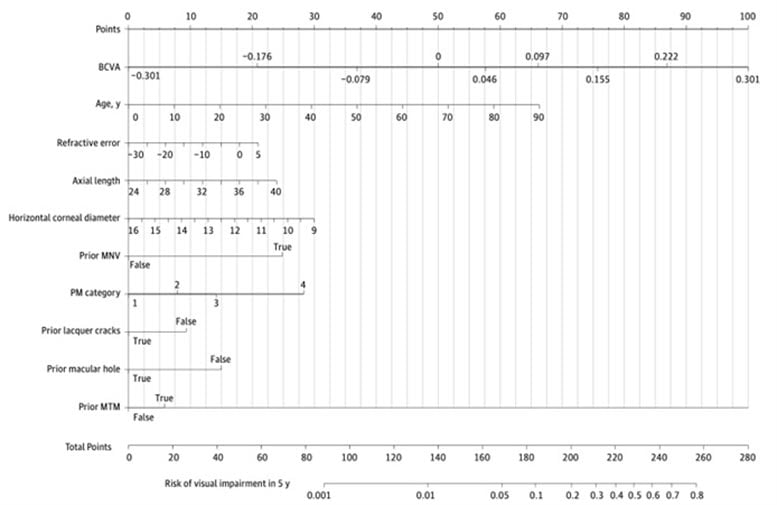
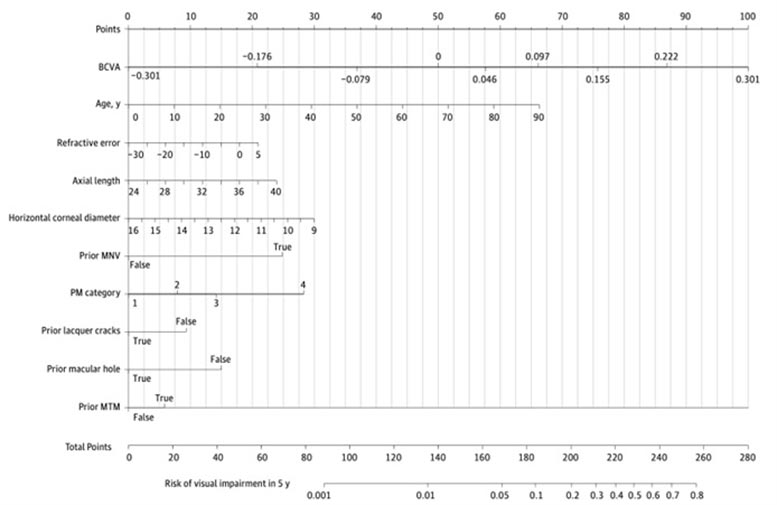
A nomogram was constructed to visualize the model. The longer the length of the line, the greater the impact of variables on the presence of VI in 5 years. Each variable had its corresponding points, which can be added to calculate the total points and the corresponding risk of VI. Credit: Department of Ophthalmology and Visual Science, TMDU
To do this, the team performed a cohort study and looked at the visual acuity of 967 Japanese patients at TDMU’s Advanced Clinical Center for Myopia after 3 and 5 years had passed. They formed a dataset from 34 variables that are commonly collected during ophthalmic examinations, such as age, current visual acuity, and the diameter of the cornea. They then tested several popular machine-learning models such as random forests and support vector machines. Of these models, the logistic regression-based model performed the best at predicting visual impairment at 5 years.
Visualizing and Addressing Visual Impairment
However, predicting outcomes is only part of the story. “It’s also important to present the model’s output in a way that is easy for patients to understand and convenient for making clinical decisions,” says Kyoko Ohno-Matsui, senior author. To do this, the researchers used a nomogram to visualize the classification model. Each variable is assigned a line with a length that indicates how important it is for predicting visual acuity. These lengths can be converted into points that can be added up to obtain a final score explaining the risk of visual impairment in future.
The Broader Impact
People who permanently lose their vision often suffer both financially and physically as a result of their loss of independence. The decrease in global productivity caused by severe visual impairment was estimated to be $94.5 billion in 2019. Although the model still has to be evaluated on a wider population, this study has shown that machine-learning models have good potential to help address this increasingly important public health concern, which will benefit both individuals and society as a whole.
Reference: “Machine Learning Models for Predicting Long-Term Visual Acuity in Highly Myopic Eyes” by Yining Wang, Ran Du, Shiqi Xie, Changyu Chen, Hongshuang Lu, Jianping Xiong, Daniel S. W. Ting, Kengo Uramoto, Koju Kamoi and Kyoko Ohno-Matsui, 26 October 2023, JAMA Ophthalmology.
DOI: 10.1001/jamaophthalmol.2023.4786
